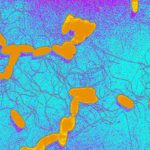Link to Pubmed [PMID] – 15314197
J. Med. Microbiol. 2004 Sep;53(Pt 9):895-901
The mechanisms of resistance to quinolone and epidemiological relationships among A. salmonicida strains isolated from diseased fish in French marine farms from 1998 to 2000 were investigated. The quinolone resistance-determining regions of the gyrA and parC genes of 12 clinical A. salmonicida isolates with different levels of quinolone susceptibility were sequenced. MICs were determined in the presence of the efflux pump inhibitor (EPI) Phe-Arg beta-naphthylamide and E(max) values (MIC without EPI/MIC in the presence of EPI) were calculated. Isolates fell into two classes: (i) those that had a wild-type gyrA gene with oxolinic acid MIC </= 0.5, flumequine MIC </= 1 and ciprofloxacin MIC Asn with oxolinic acid MIC >/= 2, flumequine MIC >/= 4 and ciprofloxacin MIC >/= 0.125 micro g ml(-1). No mutations were found in parC. High E(max) values obtained for flumequine and oxolinic acid (up to 16 and 8, respectively, for the most resistant isolates of the two classes) indicated an important contribution of efflux to the resistance phenotype. Flumequine accumulation experiments confirmed that high E(max) values were associated with a much lower level of accumulation. PCR/RFLP assays conducted on 34 additional isolates showed the presence of a mutation at codon 87 of gyrA in nearly all the quinolone-resistant isolates. This finding, together with PFGE typing results, strongly suggests a common clonal origin of these quinolone-resistant isolates.
